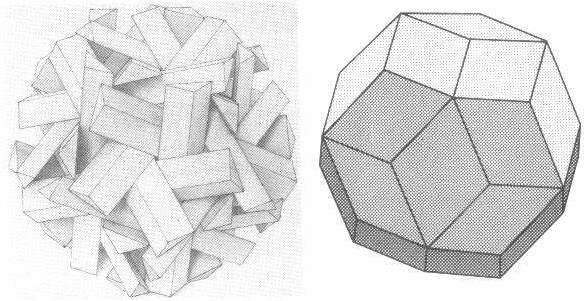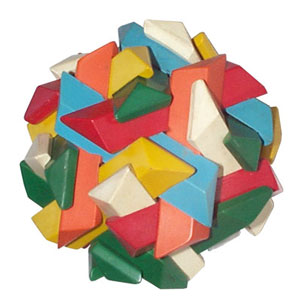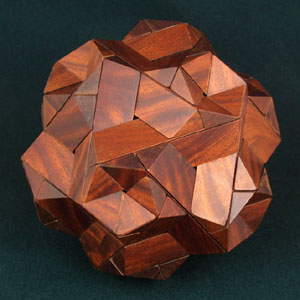
Besides the cube and the rhombic dodecahedron, the only other polyhedron that can be totally enclosed by a symmetrical arrangement of sticks is the 30-faced triacontahedron (Fig. 151).

Fig. 151
An obvious approach to exploring the geometry of the triacontahedron for practical applications is to refer back to the previous chapters in which the mating surfaces of the puzzle pieces corresponded to faces of the rhombic dodecahedron and see which designs can be carried forward by analogy into this new geometry. Straight away, one finds that there is nothing equivalent to the diagonal burr in triacontahedral geometry, so none of the designs described in Chapters 7 through 12 have triacontahedral offspring.
The cluster of 12 hexagonal sticks and dowels shown in Fig. 128 has an analogy in 30 pentagonal sticks and dowels. The version shown in Fig. 152 has seven holes in each stick. A smaller version is possible using shorter sticks and dowels, with five holes in each stick; while yet another smaller and more spherical version has only three holes in each stick. There is also one larger and more stellated version with nine holes in each stick.
Fig. 152
The construction can be extended along any one axis and the structure will repeat itself in an indefinite chain. It will not form a three-dimensional space-filling crystallographic lattice, however - none are possible having fivefold symmetries.
Pentagonal sticks are easy to make by first ripping ¾-inch boards into trapezoidal sticks and then making two more cuts, all with the saw tilted 18 degrees (Fig. 153). All of the holes are drilled at an angle of 63½ degrees to the axis of the stick, passing through the center of the stick, and parallel to one face. Determining their irregular spacing is the tricky part. It could be calculated, but the author must confess he found it simpler to locate them by trial and error. Slight inaccuracies in the 210 holes can be corrected by reaming them through in the assembled or partially assembled state using a round file in an electric drill.
Fig. 153
Assembly is entertaining and not too difficult if aided by an illustration. Of course, the use of elbow pieces as in the hexagonal counterpart would turn it into an exceedingly difficult puzzle. One can spend hours studying the assembled structure, pondering its many mysterious properties and admiring its beautiful symmetries.
In Chapter 13, a symmetrical assembly of 12 hexagonal sticks and dowels was broken into various sub-units with fewer and shorter sticks and dowels. By the same token, the assembly of 30 pentagonal sticks and dowels can be broken into interesting sub-units. One such is shown in Fig. 154 using five identical sticks and five dowels. Each stick has four holes. The assembly has fivefold symmetry. One puzzling version of it uses two elbow pieces.
Fig. 154
Note the interesting genealogy of the above offspring. It represents the conjugation of two distinctly different ideas - the pentagonal geometry of this chapter and the sub-unit scheme of Chapter 13, each with its own separate line of development, surprisingly and fortuitously joining neatly together. This happens all the time in the field of geometrical dissections and is just one more reason why this recreation is so fascinating.
The intriguing geometry of the Hectix Puzzle (Fig. 135) with its 12 notched hexagonal sticks suggests by analogy a cluster of 30 notched pentagonal sticks. Two versions of such a design are shown in Fig. 155, the difference between the two being a 36-degree rotation of the sticks. The model on the left is a mock-up only, as the sticks are so completely interlocked that any notching scheme to permit assembly would appear to cut some sticks completely in two. The complicated notching scheme that permitted assembly of the model on the right many years ago has long since been forgotten, as it has never been disassembled and serves only as a fascinating sculpture.
Fig. 155
A more practical assembly puzzle is one made with sticks of rhombic rather than pentagonal cross-section. The rhombic sticks are easily made on a table saw with the saw tilted 18 degrees. The basic piece with two notches is shown in Fig. 156a. Thirty such identical sticks are altogether impossible to assemble. The various schemes for modifying some of the pieces to permit assembly are left for the reader to invent. Careful inspection of the model shown in Fig. 156b should reveal the scheme used by the author.
Fig. 156a
Fig. 156b
In a similar vein, Bill Cutler has designed and constructed the puzzle shown in Fig 156c he calls Square-Rod Dodecaplex. It is made up of 30 notched square sticks. Other variations are no doubt possible.
Fig. 156c
The triacontahedron can be completely enclosed by an arrangement of 30 sticks of 36-108-36-degree triangular cross-section, as was shown in Fig. 151. If these triangular sticks are split longitudinally into two identical halves and then joined in fives to make 12 identical, symmetrical puzzle pieces, an interlocking configuration is obtained that is directly analogous to the Scorpius Puzzle. It has six sliding axes, and the final step of assembly is the mating of two identical halves. This puzzle likewise has the tendency to fly apart when tossed into the air, even more so than the Scorpius. In the model shown in Fig. 157, the ends of the sticks are trimmed at an angle, giving it the appearance of a stellated triacontahedron with 30 faces. One puzzle piece is outlined.
Fig. 157
Note that for all of the polyhedral design shapes included in this book, only one view of the assembly need be shown. One just naturally and automatically assumes that the structure is symmetrical, so any additional views would only be redundant. This assumption of symmetry, consistency, congruence, repetition, predictability, or call it what you will, is so commonplace, not only in geometrical recreations but in all the arts and sciences, that we scarcely give it a thought. Yet where would we be without it!
This design, as illustrated in Fig. 157, lends itself well to color symmetry problems. Six colors are used, ten sticks of each color. Each puzzle piece has arms of five different colors, arranged in such a way that when correctly assembled, all like-colored sticks are in mutually parallel matched pairs, as indicated by the outlined orange pieces in Fig. 158. Four other solutions having color symmetry are then also possible, with a simple transformation from one to another. When well crafted of six dissimilar exotic woods, it is a fine specimen of woodcraft as well as a handsome geometrical sculpture. A puzzle of this sort was produced at one time with the name of Jupiter, and so for convenience it will be referred to by that name in what follows. (Reference: US Patent Des. 232,571 to Coffin, 1974.)
Fig. 158
A favorite theme of puzzle inventors is a device that looks deceptively simple to assemble but is actually quite difficult. The Jupiter Puzzle is an amusing example of just the contrary. Most persons will not even attempt to disassemble and reassemble this intriguing polyhedral dissection, so forbidding it looks; yet it is really quite easy. Years ago, when we worked the rounds of the craft fairs, I used to have one of these puzzles as the centerpiece of our display. When a crowd had gathered, I would toss it gently so that the pieces all fell in a heap. Then I would announce: "Anyone who can put it back together can have it!" Usually no one would try, especially not adults. Our youngest, then about age seven, would be planted in the crowd, and you can guess the rest. As she finished it with a bored look, tucked it under her arm and walked off, the crowd would finally realize that it had all been just a joke on them!
The Dislocated Scorpius Puzzle has a direct analogy in the Dislocated Jupiter Puzzle, with one arm of each puzzle piece being exchanged with its mating half. This puzzle is more complicated than the Jupiter. It has at least two distinctly different mechanical solutions. Color symmetry problems are also possible. Some of the details of these remain to be worked out. One of the 12 identical puzzle pieces is shown in Fig. 159.
Fig. 159
The Scrambled Scorpius Puzzle, with its six dissimilar nonsymmetrical pieces and one solution, suggests by analogy a triacontahedral version with 12 pieces. No such design has yet been found and may not exist. If it did, it would probably be too difficult to assemble without instructions. The compromise version shown in Fig. 160 has two identical halves of six pieces each. The six pairs of puzzle pieces are all dissimilar and non-symmetrical. The puzzle has multiple solutions. It is possible to use multicolored pieces such that there is only one solution with color symmetry.

Fig. 160
The triangular sticks used in the Jupiter family of puzzles are of 36-54-90-degree cross-section. For the puzzle to be satisfactory, they must be glued together very accurately using a gluing jig with the same angles as the vertex of a triacontahedron. Probably the only practical way to make the base for such a jig is on a milling machine. The ends of the sticks should not be any longer than shown (Fig. 161) or there will be interference and the puzzle cannot easily be assembled.
Fig. 161
The 24-piece dissection of the rhombic dodecahedron in Chapter 15 leads by analogy to a 60-piece dissection of the triacontahedron, as shown in Fig. 162. John Loeser has arrived at the data given in Table 5 for the possible ways of joining such blocks into different puzzle pieces, up to size-six.
Fig. 162
Table 5
Of the 54 pieces of size-six, 45 of them are considered by us to be practical usable pieces. From among those 45, we have searched long and hard for a practical assemblable subset of 10 such pieces. So far, none has been found and it appears that perhaps none exists. But with some 20 billion different ways of choosing subsets of 10 from a set of 45, the possibility exists that we may have overlooked one! The example shown in Fig. 162 is randomly dissected simply to illustrate the principle rather than any practical solution.
Like those of the rhombic dodecahedron in Chapter 15, these individual blocks are fairly easy to make. They are sawn from 18-72-90-degree triangular cross-section stock using the same techniques. Much wood and some labor can be saved by using trapezoidal rather than triangular stock, as shown in Fig. 163, thus making the center of the puzzle hollow. The blocks are fairly easy to assemble and glue using tape and rubber bands to hold them in place. Considering the complexities and the failure to find a practical design, the potential for this dissection probably is not as an assembly puzzle but more as a geometrical sculpture, especially using multicolored exotic woods.
Fig. 163